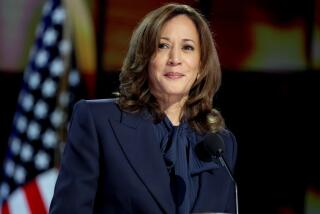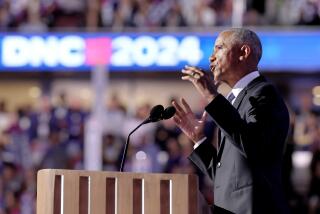Parties Defined by Where They See the Enemies
- Share via
CHICAGO — “You can judge a president by the enemies he’s willing to make,” Vice President Al Gore declared in his speech to the Democratic convention.
And, he might have added, you can just as easily judge a presidential contender by the enemies that he targets.
At their just-concluded national conventions, both parties worked to define their nominees by setting them in counterpoint to a list of political enemies. At a time when voters appear to be recoiling from direct attacks by politicians on their opponents, each party sought to play a kind of bank shot, weakening their rivals by associating them with groups the public may view with suspicion and questioning their willingness to rise above special interests to represent the national interest.
Republicans linked President Clinton to teachers’ unions (and, more broadly, union bosses), trial lawyers and, in a general way, to the forces of sexual and social liberation that have transformed American culture in the past three decades. Democrats last week wrapped Republican nominee Bob Dole in the arms of the National Rifle Assn., the tobacco industry, polluters and the Republican Congress led by House Speaker Newt Gingrich (R-Ga.).
In both cases, the targets that the parties spared were just as revealing. Worried about the gender gap, Republicans focused much less fire on feminists and abortion-rights advocates than conservatives often do. Even more strikingly, the Democrats last week uttered hardly a peep of criticism of either big business or religious conservatives--two targets that don’t fit into Clinton’s centrist, non-populist, family-focused reelection strategy.
Compared to 1994, when anger at Clinton’s efforts to expand government inspired an outpouring of grass-roots energy on the right, some consultants in both parties say they think that Democrats may have a more resonant set of opponents to play off against this fall.
Voter Targets
When voters were asked in a recent survey by Democratic pollster Stanley B. Greenberg which groups’ influence on the parties they most feared, tobacco companies topped the list, with the NRA finishing in the middle of the pack; lower still were Democratic allies like unions and gay-rights advocates. (Also generating little concern were religious conservatives.)
“If voters view the parties by their opponents,” said one GOP operative, “it’s pretty clear who has the better enemies this cycle.”
At least during the prime-time TV hours, when they had the largest audiences, neither convention was particularly vitriolic in attacking anyone. Both parties were mindful of focus-group research showing that voters, especially independents, dislike partisan attacks and yearn for leaders who can reach across party lines.
But within those constraints, both sides managed to land a pattern of blows that traced a revealing outline of their election strategies.
In choosing their targets, the Republicans hope to challenge Clinton’s portrayal of himself as a moderate. By linking Clinton to teachers’ unions, Dole and other Republicans aim to raise doubts about the president’s willingness to reform education, particularly by providing parents with vouchers for private schools, a proposal that teachers’ unions loathe. And by tying the president to trial lawyers, the GOP seeks to question Clinton’s willingness to reform the civil justice system.
“The teachers’ unions and trial lawyers are good targets because . . . Clinton can’t move to the center on those issues,” said Fred Steeper, a Republican pollster advising Dole.
Unions and NRA
In targeting “union bosses,” Republicans hope to send an ideological message but also open a wedge between the leadership of organized labor, which has launched a multimillion-dollar ad campaign to oust the GOP from control of Congress, and rank-and-file members, many of whom have previously supported GOP candidates.
The Democrats targeted a contrasting set of enemies at their convention. Although Gingrich fits into a separate category, and actually received surprisingly light treatment during prime time, the principal Democratic targets were all groups that raise concerns among the suburban, married voters who are the main focus of the Clinton campaign.
At the top of the target list was the NRA.
“The gun lobby is wrong,” gun-control advocate Sarah Brady said Monday night.
Unless the government stands up “to special interests like the NRA leadership, we are not going to have safety on our streets,” congressional candidate Carolyn McCarthy said Tuesday night.
Clinton “took on the gun lobby . . . and he won,” said Sen. Christopher J. Dodd (D-Conn.) Wednesday night.
One Republican pollster said this wasn’t a surprise, given the Clinton campaign’s goal of swelling the gender gap. “If you want to polarize women, the gun stuff is a very, very effective argument . . . because women just don’t understand why you need big weaponry,” said GOP pollster Bill McInturff.
After the NRA, the most frequent Democratic target was the tobacco industry, which is battling with Clinton over new Food and Drug Administration regulations limiting cigarette advertising aimed at young people.
One senior Clinton campaign advisor said both the gun-control and tobacco issues were particularly effective because they strike at the Republican efforts to paint themselves as tough on crime and supportive of families. Moreover, surveys show that the drive against teenage smoking draws high marks from many socially conservative voters, especially stay-at-home mothers.
“They may have scored more points on the cigarette debate than the Republican Party realizes with parents, specifically those who have conservative religious backgrounds,” said Gary Bauer, president of the conservative Family Research Council. “For those folks, smoking was a bad thing long before it became politically incorrect.”
Still, neither attack is without political risk for Clinton. Democrats from tobacco-growing states fear his assault on cigarette advertising could make their task tougher in November. Picking on the NRA could be even riskier: Even though polls show that strong majorities of Americans support gun-control initiatives such as the ban on semiautomatic assault weapons, the organization demonstrated in 1994 an enormous ability to mobilize gun-control opponents to vote on that issue alone.
Wayne LaPierre, the NRA’s executive vice president, said gun owners had not “felt very threatened” the past two years but were likely to be mobilized by the “in-your-face” message from the Democratic convention.
Strategy of Silence
If gun owners were organized into high activity in the campaign, it might cause problems for Clinton in industrial-state battlegrounds, such as Michigan and Pennsylvania, and Southern states. But it’s unclear whether the NRA will mount that kind of effort: Because Dole has renounced his promise to seek repeal of the assault weapon ban, and because the GOP convention devoted virtually no attention to the group’s agenda, LaPierre says the NRA “may very well not endorse” the Republican nominee.
To liberals, the 1.7-million-member Christian Coalition ranks perhaps even above the NRA in the pantheon of favored enemies. But in contrast to the NRA, the Christian Coalition received gentle treatment at the convention.
Apart from a passing reference by the Rev. Jesse Jackson to the group’s executive director, Ralph Reed, no major speaker until Sen. Edward M. Kennedy (D-Mass.) on the convention’s last night uttered any criticism of the group in particular or the “religious right” in general. And even Kennedy’s sharp jab occurred well outside of prime time.
Reed interpreted the relatively kid-glove treatment as a sign that Democrats realize their efforts in earlier campaigns to target religious conservatives had been ineffective. “What happened is the Democratic Party recognizes the mistake they made in 1994 when they tried to demonize religious conservatives . . . ,” he said.
Another consideration may have encouraged Democrats to sheathe their swords. The principal demographic group at which they targeted their convention message, married couples with children, attends church much more regularly than single Americans and might resist messages criticizing religious leaders of any sort. “If you’re going to be the party of values, why would you be trashing people of faith?” McInturff said.
Easing Up on Rich
Apart from the tobacco industry and some general references to “polluters,” the Democratic convention also was notable for the muting of attacks on business or the wealthy, especially during prime time. In his speech accepting the nomination, Clinton offered no criticism of business at all; when he indicted Dole’s call for the cut in income tax rates, he notably omitted the traditional Democratic charge that it would benefit the rich. His silence loudly contrasted with the populist zingers he salted through his 1992 acceptance speech.
Like the decision to pass over the Christian Coalition, this year’s conciliatory approach may reflect the campaign’s focus on suburban parents. Clinton’s most influential political advisors believe that these voters are basically satisfied with their economic situation and are left cold by anything approaching economic populism.
But more traditional Democrats worry that in his eagerness to rise above class divisions, Clinton left the field dangerously open for Dole to reach working-class voters frustrated by wages growing slowly or not at all.
“John Sweeney, the AFL-CIO president, says the question is that America needs a raise,” said Jeff Faux, president of the Economic Policy Institute, a liberal think tank. “Dole says you get it by cutting taxes. Clinton’s answer to that is not clear.”
More to Read
Get the L.A. Times Politics newsletter
Deeply reported insights into legislation, politics and policy from Sacramento, Washington and beyond. In your inbox twice per week.
You may occasionally receive promotional content from the Los Angeles Times.










